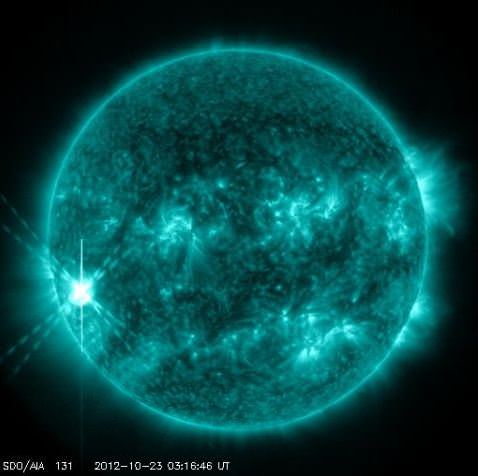An active region just turning into view on the left side of the Sun has emitted three large flares since Saturday: an M9, an M5 and early today blasted out an X1.8 class flare. This flare occurred around 3:17 am UTC today (or 11:17 pm EDT on Oct. 22). The strobe-light-like effect visible in the video was created by the brightness of the flare and how the instruments on the Solar Dynamics Observatory responded to it. Phil Chamberlin, Deputy Project Scientist SDO told Universe Today that built in algorithms called 'active exposure control' compensate for the extra light coming in from a flare. It doesn't always result in the strobe or fluttering effect, but the algorithms create shorter exposure time, and thus a dimmer, but still scientifically useful view of the entire Sun. The algorithms go into effect whenever there is an M class or higher flare.
Solar flares are powerful bursts of radiation. Harmful radiation from a flare can't pass through Earth's atmosphere and pose a hazard to humans on the ground, but flares like this can disturb the atmosphere in the layer where GPS and communications signals travel, and an X-class flare of this intensity can cause problems or even blackouts in radio communications.
A Coronal Mass Ejection (CME) was not associated with this flare, and the flare was not directed at Earth, so scientists do not expect any additional auroral activity to be a result of this latest blast from the Sun.
An image from the Solar Dynamics Observatory during the X-class flare event on Oct. 23, 2012 (UTC). Credit: NASA/SDO
The
SDO Twitter feed
said there is a 75% chance of more M-class solar flares from this active region and a 20% chance of additional X-class flares.
This is the 7th X-class flare in 2012 with the largest being an X5.4 flare on March 7.
By observing the sun in a number of different wavelengths, NASA's telescopes can tease out different aspects of events on the sun. These four images of a solar flare on Oct. 22, 2012, show from the top left, and moving clockwise: light from the sun in the 171 Angstrom wavelength, which shows the structure of loops of solar material in the sun's atmosphere, the corona; light in 335 Angstroms, which highlights light from active regions in the corona; a magnetogram, which shows magnetically active regions on the sun; light in the 304 Angstrom wavelength, which shows light from the region of the sun's atmosphere where flares originate. (Credit: NASA/SDO/Goddard)
More info:
NASA
,
SpaceWeather.com
 Universe Today
Universe Today
